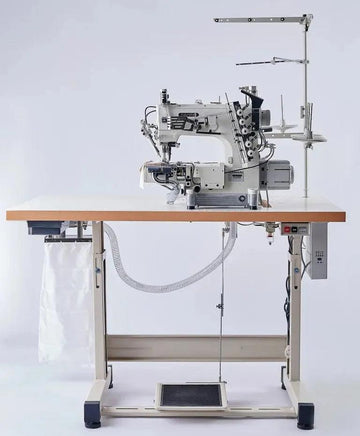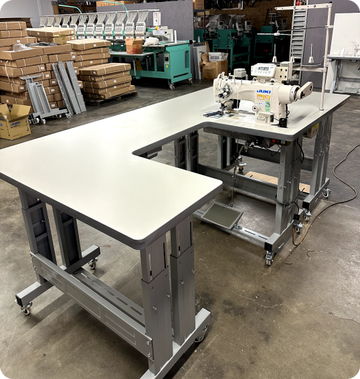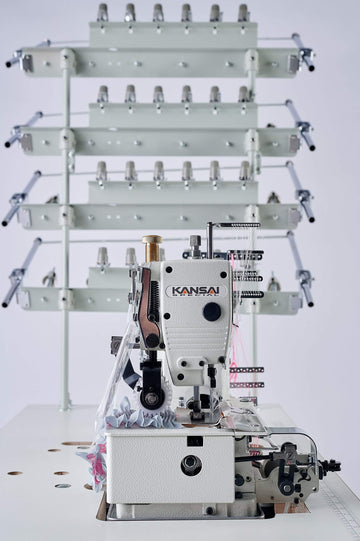Introduction
If you’ve ever unboxed a new sewing machine and immediately felt intimidated by that tiny metal spool hidden underneath the needle plate, you’re in good company. Many beginners struggle to understand how to set up the bobbin in a sewing machine, yet it’s one of the most critical steps in sewing success. Without a properly wound and inserted bobbin, your stitches can unravel, loop, or bunch — and even the most advanced machine won’t produce clean results.
Learning how to set up a sewing machine bobbin correctly transforms sewing from a frustrating chore into a satisfying creative process. Whether you’re working on a home project in Los Angeles, setting up an industrial sewing table in South El Monte, or using a compact model for travel, this guide will walk you through every version — including how to set up a bobbin on a sewing machine, how to set up a sewing machine with bobbin, and even how to set up bobbin in mini sewing machine.
By the end, you’ll not only know how to thread and insert the bobbin but also how to troubleshoot common issues, maintain your equipment, and keep your stitches looking professional and consistent.
What Is a Bobbin and Why It Matters
The bobbin is the unsung hero of every sewing project. It’s a small spool that holds the lower thread, creating the underside of each stitch. While the top thread comes down from the needle, the bobbin thread rises from below, and the two interlock to form a balanced, strong seam.
Without the correct sewing machine bobbin set up, your stitches may skip, your fabric could pucker, or your thread might jam inside the casing. The goal of perfect sewing is balanced tension between the upper and lower threads — and that balance starts with the bobbin.
In short, a well-set-up bobbin equals professional-quality stitches, smoother operation, and fewer interruptions while you sew.
Tools and Preparation Before You Begin
Before learning how to set up a sewing machine bobbin, make sure you have the right tools on hand. Preparation not only saves time but also protects your machine and fabric.
You’ll need:
-
Thread (choose a high-quality, smooth type suited for your fabric)
-
Empty bobbin (plastic or metal, depending on your model)
-
Scissors or thread snips
-
A clean, stable sewing table or surface
-
Your sewing machine manual (for brand-specific details)
Quick setup tips:
-
Unplug the sewing machine while winding or inserting the bobbin.
-
Always check that your bobbin matches your machine brand and model—mismatched sizes can cause skipped stitches.
-
Use the same type and weight of thread on both the top spool and the bobbin for consistent tension.
Read Also: How to Set Up a Sewing Machine Step by Step: The Ultimate Beginner’s Guide
Step 1: Winding the Bobbin
The first part of any sewing machine bobbin set up is winding your thread onto the bobbin. This step ensures that the lower thread feeds evenly and smoothly during sewing.
Here’s how to wind it correctly:
-
Place your spool of thread on the spool pin.
-
Guide the thread through the upper thread guide and tension disc.
-
Insert the end of the thread through the hole in your empty bobbin from inside to out.
-
Place the bobbin on the bobbin winder spindle and push it to the right to engage.
-
Hold the thread tail and start your machine or press the foot pedal.
-
Let the bobbin fill evenly—stop when it’s about 80–90% full.
-
Cut the thread and remove the bobbin.
Avoid these common mistakes:
-
Don’t overfill the bobbin—too much thread causes jamming.
-
Make sure the winding is even from side to side.
-
If your bobbin looks uneven or loose, unwind and redo it.
Winding carefully is the foundation of a proper sewing machine set up bobbin and will prevent issues later when you start stitching.
Step 2: Inserting the Bobbin
Now comes the crucial step of inserting your bobbin into the machine. There are two main styles: top-loading (drop-in) and front-loading (bobbin case). Understanding both is key when learning how to set up a sewing machine bottom bobbin.
Top-Loading (Drop-In) Bobbin
-
Turn off the machine.
-
Slide open the clear bobbin cover.
-
Drop the bobbin into the case so the thread unwinds counterclockwise.
-
Pull the thread through the guide slot and under the tension spring.
-
Replace the cover and pull a few inches of thread free.
Drop-in bobbins are common in modern machines because they’re user-friendly and allow you to see how much thread remains.
Front-Loading (Removable Case) Bobbin
-
Open the small door on the front of your machine.
-
Remove the bobbin case.
-
Insert the bobbin, making sure the thread unwinds clockwise.
-
Pull the thread through the slit and under the tension spring.
-
Insert the case back into the shuttle until you hear a click.
Front-loading systems are popular in industrial and commercial machines used across California workshops because they offer precise tension control and durability.
Step 3: Drawing Up the Bobbin Thread
Once inserted, it’s time to pull up the lower thread and prepare for sewing.
-
Hold the upper thread with your left hand.
-
Turn the handwheel toward you to lower and then raise the needle once.
-
The needle will catch the bobbin thread and pull up a loop.
-
Pull both threads together under the presser foot and toward the back.
This is the moment when your set up sewing machine bobbin process comes together — both threads are connected, tension is balanced, and you’re ready to sew.
Special Cases
How to Set Up Bobbin in Mini Sewing Machine
Mini sewing machines often feature simplified drop-in bobbins. The process is similar but quicker:
-
Open the bobbin compartment.
-
Drop in your pre-wound bobbin.
-
Pull the thread through the slot and toward the needle.
-
Use the handwheel to lift the bobbin thread.
These compact machines are great for small projects or travel sewing kits but still require precision in bobbin setup.
How to Set Up a Sewing Machine Without a Bobbin
Some chain-stitch machines and embroidery units work without a bobbin. Instead of two interlocking threads, they use a single-thread looping system underneath. While these machines are fast and efficient, they don’t produce the same lockstitch found in traditional sewing machines. Always verify whether your machine requires a bobbin before beginning any project.
Troubleshooting Common Bobbin Problems
Even with perfect setup, issues can occur. Here’s how to identify and fix them:
-
Thread bunching underneath fabric: Rethread both the top and bobbin paths; one may be misaligned.
-
Uneven winding: Wind the bobbin again at a steady speed.
-
Machine not picking up bobbin thread: Ensure the needle is inserted correctly and the bobbin spins in the proper direction.
-
Loud or jerky movement: Clean lint from the bobbin area and check that your case isn’t damaged.
Knowing these quick fixes saves you frustration and keeps your sewing sessions productive.
Maintenance Tips for Long-Term Use
Taking care of your sewing machine bobbin set up ensures it stays in top condition for years.
-
Clean the bobbin case and surrounding area regularly using a soft brush.
-
Use a small vacuum or compressed air to remove lint buildup.
-
Oil your machine as recommended by the manufacturer.
-
Store wound bobbins upright in a case to prevent tangling.
-
Replace damaged bobbins immediately — even a small crack can ruin your stitch quality.
Professional tailors and sewing studios across Los Angeles and South El Monte follow strict maintenance routines because clean, well-kept machines always produce consistent, high-quality results.
Conclusion
Mastering how to set up the bobbin in a sewing machine might seem small, but it’s a big step toward sewing confidence. From how to set up a bobbin on a sewing machine to understanding how to set up a sewing machine without a bobbin, every variation adds to your skill set.
Once you’ve practiced a few times, setting up your bobbin will become second nature. You’ll spend less time fixing tangled threads and more time creating beautiful garments, quilts, and home décor projects.
So go ahead — wind that bobbin, thread your needle, and start stitching something uniquely yours. The rhythm of the machine, the hum of the motor, and the satisfaction of a perfect seam all begin with one simple skill: a flawless sewing machine bobbin set up.










